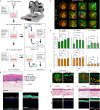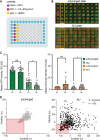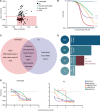Limitations of acyclovir and identification of potent HSV antivirals using 3D bioprinted human skin equivalents
- PMID: 41102222
- PMCID: PMC12533247
- DOI: 10.1038/s41467-025-64245-w
Limitations of acyclovir and identification of potent HSV antivirals using 3D bioprinted human skin equivalents
Abstract
Herpes simplex virus (HSV) infection poses global public health concerns with lifelong impacts. Acyclovir, the standard therapy, has limited efficacy in preventing subclinical shedding, and drug resistance occurs in immunocompromised patients, highlighting the need for novel therapeutics. Here we show that acyclovir is significantly less effective in skin-derived keratinocytes than donor-matched fibroblasts. Using 3D bioprinted human skin equivalents (HSEs) in a 96-well plate format, we have screened 738 compounds with broad targets and mechanisms of action, identifying potent antivirals, including 23 known or experimental HSV treatments. Unlike acyclovir, antivirals against HSV helicase/primase or host replication pathways display similar potency across cell types and donor sources in both 2D and 3D models. The reduced potency in keratinocytes may explain acyclovir's limited clinical efficacy. Our 3D bioprinted HSE assay platform enables the integration of patient-derived cells early in drug development and offers a physiologically relevant approach for HSV drug discovery.
© 2025. This is a U.S. Government work and not under copyright protection in the US; foreign copyright protection may apply.
Conflict of interest statement
Competing interests: The authors declare no competing interests.
Figures








References
-
- Gupta, R., Warren, T. & Wald, A. Genital herpes. Lancet370, 2127–2137 (2007). - PubMed
-
- James, S. H. & Kimberlin, D. W. Neonatal herpes simplex virus infection. Infect. Dis. Clin. North Am.29, 391–400 (2015). - PubMed
-
- Corey, L., Wald, A., Celum, C. L. & Quinn, T. C. The effects of herpes simplex virus-2 on HIV-1 acquisition and transmission: a review of two overlapping epidemics. J. Acquir Immune Defic. Syndr.35, 435–445 (2004). - PubMed
MeSH terms
Substances
Grants and funding
- U18 TR0033208/U.S. Department of Health & Human Services | NIH | National Center for Advancing Translational Sciences (NCATS)
- T32 AI007140/AI/NIAID NIH HHS/United States
- U18 TR003208/TR/NCATS NIH HHS/United States
- T32 AI07140/U.S. Department of Health & Human Services | NIH | National Institute of Allergy and Infectious Diseases (NIAID)
- R01 AI143773/AI/NIAID NIH HHS/United States
LinkOut - more resources
Full Text Sources
Medical

